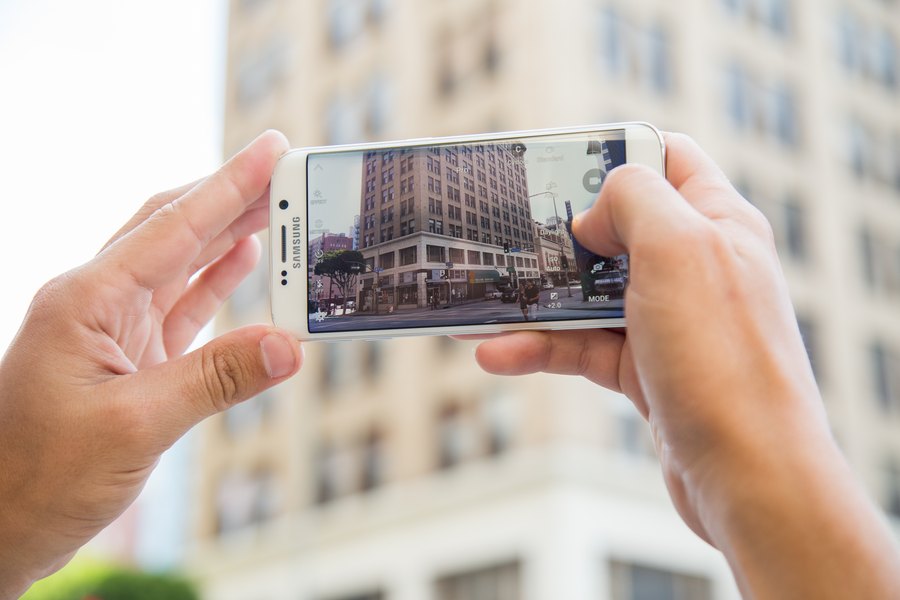
If you had a time machine, there's no doubt you could absolutely floor yesterday's photographers with the 16-megapixel glory of your Samsung Galaxy S®6 edge or Galaxy S®6 rear-facing camera—assuming they actually understood the word “megapixel.” While the photogs of yore might've been lugging a few pounds of kit around their necks, they knew their tools, in and out. Luckily, changing your phone's camera mode from “Auto” to “Pro” melds forward-facing tech with enough tweaking and fine-tuning to satisfy any pro, old or new.

Go Big With 4K
Forging a path right past Full HD, the camera captures images in uber-crisp, ultra-detailed 4K. By setting your resolution to the maximum size under “Picture size,” even a snapshot of your bare feet chilling on the couch becomes a mega-detailed, super-crisp photographic journey.

Expose Yourself (Not Like That)
Once you're grabbing 4K shots in Pro mode, take advantage of the exposure value menu, which adjusts how much light the sensor takes in. Low or negative exposure makes for a darker snap, while high exposure yields a brighter pic. Next time you're contending with the shadowy atmosphere at the gastropub, crank up the exposure to nab a perfectly plated appetizer photo that'll look right at home in any cookbook.

Feed Your Meter
Now that you've got a handle on exposure value, it's time to explore your metering modes, also accessible under the camera settings. This toggle lets your phone's camera know which part of the image is most important, in terms of exposure. By default, center-weighted metering makes for a brighter middle portion of the photo, while matrix metering—a boon for group shots—offers an all-around balanced image. To make one small subject pop, use spot metering. Try that one the next time you want to do your vase of birthday flowers justice.

Get Dynamic
Step One: Impress your photo-savvy friends by knowing that “HDR” stands for “high dynamic range.” Step Two: Turn HDR on in your camera settings menu when dealing with a high-contrast mix of dark and light subjects, like the blue sky and stark buildings surrounding that perfect rainbow you spotted on the way to work. Step Three: Enjoy rich, vibrant photos that look like they took a lot more finesse than they actually did.

Be Selective
Turn on selective focus under your camera settings, and then take anything around the house—the windowsill herb garden you've manicured to salad-readiness, a new pair of lipstick-red heels, or maybe the glorious vintage turntable you rescued from the swap meet. Now capture your subject from a distance of about 1.5 feet, with key background elements—say, the window or wall—about 5 feet past that. Once you've taken your shot, choose from near focus, far focus or pan focus to lend your image a pro-quality depth-of-field effect, blurring select parts of the image. And you didn't even have to spend $20,000 on a photography degree.

Live On the Grid
Toggle on your grid lines, found under the camera settings, to take even the simplest compositions to the next level. This three-by-three grid separates your viewing field into horizontal and vertical thirds. For a well-balanced photo, keep your subject confined to one of those thirds. Grid lines work on both the front and rear cameras, so you can even use them to elevate your selfie skills from "eh" to "epic."

Go Pro and Stay Pro
Now that you've opened up your world to the Pro settings, you can play mad photographic scientist, tinkering with everything from white balance to ISO (that's the sensitivity of the image sensor). Great tinkering deserves to be documented for the ages; once you've found the settings that best suit your style, open up the camera viewfinder and tap "Custom," and then "Save current settings." You'll have three slots to save custom settings, so feel free to tinker, tweak and finesse the settings till your inner photographer is content.



কোন মন্তব্য নেই:
একটি মন্তব্য পোস্ট করুন